c7d61b04da25e5d5316c35197185909d.ppt
- Количество слайдов: 78
 Surfactant Ergonomics: The Human Sensory System and Information Processing Chapter 24 1. 2. 3. 4. 5. 6. 7. Sections: The Human Sensory System Perception Attention Resources Memory Response Selection and Execution Common Cognitive Tasks Design Guidelines for Cognitive Work Systems and the Methods, Measurement, and Management of Work by Mikell P. Groover, ISBN 0 -13 -140650 -7. © 2007 Pearson Education, Inc. , Upper Saddle River, NJ. All rights reserved.
Surfactant Ergonomics: The Human Sensory System and Information Processing Chapter 24 1. 2. 3. 4. 5. 6. 7. Sections: The Human Sensory System Perception Attention Resources Memory Response Selection and Execution Common Cognitive Tasks Design Guidelines for Cognitive Work Systems and the Methods, Measurement, and Management of Work by Mikell P. Groover, ISBN 0 -13 -140650 -7. © 2007 Pearson Education, Inc. , Upper Saddle River, NJ. All rights reserved.
 Cognitive Ergonomics Study of the capabilities and limitations of the human brain and sensory system while performing activities that have a significant information processing content § Why cognitive ergonomics is important § Growth in the service industry sector in which work has high content of information processing and communication § More use of mechanization and automation § Increased use of technologically sophisticated equipment Work Systems and the Methods, Measurement, and Management of Work by Mikell P. Groover, ISBN 0 -13 -140650 -7. © 2007 Pearson Education, Inc. , Upper Saddle River, NJ. All rights reserved.
Cognitive Ergonomics Study of the capabilities and limitations of the human brain and sensory system while performing activities that have a significant information processing content § Why cognitive ergonomics is important § Growth in the service industry sector in which work has high content of information processing and communication § More use of mechanization and automation § Increased use of technologically sophisticated equipment Work Systems and the Methods, Measurement, and Management of Work by Mikell P. Groover, ISBN 0 -13 -140650 -7. © 2007 Pearson Education, Inc. , Upper Saddle River, NJ. All rights reserved.
 Human Information Processing Model Work Systems and the Methods, Measurement, and Management of Work by Mikell P. Groover, ISBN 0 -13 -140650 -7. © 2007 Pearson Education, Inc. , Upper Saddle River, NJ. All rights reserved.
Human Information Processing Model Work Systems and the Methods, Measurement, and Management of Work by Mikell P. Groover, ISBN 0 -13 -140650 -7. © 2007 Pearson Education, Inc. , Upper Saddle River, NJ. All rights reserved.
 Human Sensory System § § Humans receive stimuli from sources of energy both external and internal to the body Receptors - the body’s sensory organs: 1. Vision ~ 80% of human information input 2. Hearing ~ 15% to 19% of information input 3. Touch 4. Smell 5. Taste Work Systems and the Methods, Measurement, and Management of Work by Mikell P. Groover, ISBN 0 -13 -140650 -7. © 2007 Pearson Education, Inc. , Upper Saddle River, NJ. All rights reserved.
Human Sensory System § § Humans receive stimuli from sources of energy both external and internal to the body Receptors - the body’s sensory organs: 1. Vision ~ 80% of human information input 2. Hearing ~ 15% to 19% of information input 3. Touch 4. Smell 5. Taste Work Systems and the Methods, Measurement, and Management of Work by Mikell P. Groover, ISBN 0 -13 -140650 -7. © 2007 Pearson Education, Inc. , Upper Saddle River, NJ. All rights reserved.
 Vision § Light - electromagnetic radiant energy that lies within the visible spectrum § Wavelengths between ~ 400 nm (blue-violet) and ~ 700 nm (red) A very narrow band. § Human eye is stimulated by light § Light passes through the cornea (the eyeball’s window) and is focused by the lens onto the retina at the back of the eyeball § The retina consists of millions of light receptors. Cones and rods (high or low illumination) § The optic nerve transmits the image focused on the retina to the brain for interpretation Work Systems and the Methods, Measurement, and Management of Work by Mikell P. Groover, ISBN 0 -13 -140650 -7. © 2007 Pearson Education, Inc. , Upper Saddle River, NJ. All rights reserved.
Vision § Light - electromagnetic radiant energy that lies within the visible spectrum § Wavelengths between ~ 400 nm (blue-violet) and ~ 700 nm (red) A very narrow band. § Human eye is stimulated by light § Light passes through the cornea (the eyeball’s window) and is focused by the lens onto the retina at the back of the eyeball § The retina consists of millions of light receptors. Cones and rods (high or low illumination) § The optic nerve transmits the image focused on the retina to the brain for interpretation Work Systems and the Methods, Measurement, and Management of Work by Mikell P. Groover, ISBN 0 -13 -140650 -7. © 2007 Pearson Education, Inc. , Upper Saddle River, NJ. All rights reserved.
 Anatomy of the Human Eyeball Work Systems and the Methods, Measurement, and Management of Work by Mikell P. Groover, ISBN 0 -13 -140650 -7. © 2007 Pearson Education, Inc. , Upper Saddle River, NJ. All rights reserved.
Anatomy of the Human Eyeball Work Systems and the Methods, Measurement, and Management of Work by Mikell P. Groover, ISBN 0 -13 -140650 -7. © 2007 Pearson Education, Inc. , Upper Saddle River, NJ. All rights reserved.
 Visual Performance Four performance measures § Visual acuity - capability to discriminate small objects or fine details Visual angle v = 3438 h/d where v is measured in arc min (1/60 of minute), h = height of object or detail, and d = distance from eye Visual acuity VA = 1/ v (reciprocal of visual angle) If VA =1 normal visual acuity § Snellen chart - test for visual acuity § Used by opthalmologists § Patient asked to identify letters as their sizes get smaller and smaller § The usual distance is 6 m § Legally blind 20/200 § See p. 614 Work Systems and the Methods, Measurement, and Management of Work by Mikell P. Groover, ISBN 0 -13 -140650 -7. © 2007 Pearson Education, Inc. , Upper Saddle River, NJ. All rights reserved.
Visual Performance Four performance measures § Visual acuity - capability to discriminate small objects or fine details Visual angle v = 3438 h/d where v is measured in arc min (1/60 of minute), h = height of object or detail, and d = distance from eye Visual acuity VA = 1/ v (reciprocal of visual angle) If VA =1 normal visual acuity § Snellen chart - test for visual acuity § Used by opthalmologists § Patient asked to identify letters as their sizes get smaller and smaller § The usual distance is 6 m § Legally blind 20/200 § See p. 614 Work Systems and the Methods, Measurement, and Management of Work by Mikell P. Groover, ISBN 0 -13 -140650 -7. © 2007 Pearson Education, Inc. , Upper Saddle River, NJ. All rights reserved.
 Visual Angle Defined Visual angle v = 3438 h/d Work Systems and the Methods, Measurement, and Management of Work by Mikell P. Groover, ISBN 0 -13 -140650 -7. © 2007 Pearson Education, Inc. , Upper Saddle River, NJ. All rights reserved.
Visual Angle Defined Visual angle v = 3438 h/d Work Systems and the Methods, Measurement, and Management of Work by Mikell P. Groover, ISBN 0 -13 -140650 -7. © 2007 Pearson Education, Inc. , Upper Saddle River, NJ. All rights reserved.
 Visual Performance § Stereoscopic acuity - capability to perceive depth in one’s field of vision § Enabled by the two eyes (the brain processes and integrates two pictures and estimate app. distance) § Estimating the distance for near objects is more accurate than for far away objects Work Systems and the Methods, Measurement, and Management of Work by Mikell P. Groover, ISBN 0 -13 -140650 -7. © 2007 Pearson Education, Inc. , Upper Saddle River, NJ. All rights reserved.
Visual Performance § Stereoscopic acuity - capability to perceive depth in one’s field of vision § Enabled by the two eyes (the brain processes and integrates two pictures and estimate app. distance) § Estimating the distance for near objects is more accurate than for far away objects Work Systems and the Methods, Measurement, and Management of Work by Mikell P. Groover, ISBN 0 -13 -140650 -7. © 2007 Pearson Education, Inc. , Upper Saddle River, NJ. All rights reserved.
 Visual Performance § Color discrimination - capability to distinguish colors § Rod type cells are not color sensitive=> conclusion? § Cone cells are of three types. Red, Blue, and green. § A yellow object stimulates ………… types of cells? § 15% of people are affected by color blindness. § Monochromats can see only tones of grey. (complete color blindness) § Traffic lamps Work Systems and the Methods, Measurement, and Management of Work by Mikell P. Groover, ISBN 0 -13 -140650 -7. © 2007 Pearson Education, Inc. , Upper Saddle River, NJ. All rights reserved.
Visual Performance § Color discrimination - capability to distinguish colors § Rod type cells are not color sensitive=> conclusion? § Cone cells are of three types. Red, Blue, and green. § A yellow object stimulates ………… types of cells? § 15% of people are affected by color blindness. § Monochromats can see only tones of grey. (complete color blindness) § Traffic lamps Work Systems and the Methods, Measurement, and Management of Work by Mikell P. Groover, ISBN 0 -13 -140650 -7. © 2007 Pearson Education, Inc. , Upper Saddle River, NJ. All rights reserved.
 Visual Performance § Adaptation - ability to adapt to changes in light levels § Dark adaptation - adapting from a bright environment to a dark one. It takes a long time § Light adaptation - adapting from a dark environment to a light one. Very quick Work Systems and the Methods, Measurement, and Management of Work by Mikell P. Groover, ISBN 0 -13 -140650 -7. © 2007 Pearson Education, Inc. , Upper Saddle River, NJ. All rights reserved.
Visual Performance § Adaptation - ability to adapt to changes in light levels § Dark adaptation - adapting from a bright environment to a dark one. It takes a long time § Light adaptation - adapting from a dark environment to a light one. Very quick Work Systems and the Methods, Measurement, and Management of Work by Mikell P. Groover, ISBN 0 -13 -140650 -7. © 2007 Pearson Education, Inc. , Upper Saddle River, NJ. All rights reserved.
 Hearing § § Process of perceiving sound § The sensation is stimulated by acoustic waves - air pressure oscillations A simple sound-generating source produces a pure tone, which is characterized by two physical attributes: 1. Frequency (Hz) - perceived as pitch 2. Intensity (d. B) - perceived as loudness Work Systems and the Methods, Measurement, and Management of Work by Mikell P. Groover, ISBN 0 -13 -140650 -7. © 2007 Pearson Education, Inc. , Upper Saddle River, NJ. All rights reserved.
Hearing § § Process of perceiving sound § The sensation is stimulated by acoustic waves - air pressure oscillations A simple sound-generating source produces a pure tone, which is characterized by two physical attributes: 1. Frequency (Hz) - perceived as pitch 2. Intensity (d. B) - perceived as loudness Work Systems and the Methods, Measurement, and Management of Work by Mikell P. Groover, ISBN 0 -13 -140650 -7. © 2007 Pearson Education, Inc. , Upper Saddle River, NJ. All rights reserved.
 Sound: A Pure Tone Sinusoidal pressure oscillations of a simple soundgenerating source P. 616 Work Systems and the Methods, Measurement, and Management of Work by Mikell P. Groover, ISBN 0 -13 -140650 -7. © 2007 Pearson Education, Inc. , Upper Saddle River, NJ. All rights reserved.
Sound: A Pure Tone Sinusoidal pressure oscillations of a simple soundgenerating source P. 616 Work Systems and the Methods, Measurement, and Management of Work by Mikell P. Groover, ISBN 0 -13 -140650 -7. © 2007 Pearson Education, Inc. , Upper Saddle River, NJ. All rights reserved.
 Power Spectrum of a Sound Continuous power spectrum of a sound consisting of multiple frequencies Work Systems and the Methods, Measurement, and Management of Work by Mikell P. Groover, ISBN 0 -13 -140650 -7. © 2007 Pearson Education, Inc. , Upper Saddle River, NJ. All rights reserved.
Power Spectrum of a Sound Continuous power spectrum of a sound consisting of multiple frequencies Work Systems and the Methods, Measurement, and Management of Work by Mikell P. Groover, ISBN 0 -13 -140650 -7. © 2007 Pearson Education, Inc. , Upper Saddle River, NJ. All rights reserved.
 Sound Intensity § Measured as pressure, e. g. , N/m 2 or Pa § However, range of sound pressures is very large (0. 00002 N/m 2 to 20 N/m 2) § Thus, intensity is converted to logarithmic scale, called sound pressure level (SPL) with units of decibel (d. B): SPL = 20 log 10(ps / pr) where ps = sound pressure from source, N/m 2 , and pr = reference sound pressure, N/m 2 (the usual reference pressure is 0. 00002 N/m 2 , threshold of hearing) Work Systems and the Methods, Measurement, and Management of Work by Mikell P. Groover, ISBN 0 -13 -140650 -7. © 2007 Pearson Education, Inc. , Upper Saddle River, NJ. All rights reserved.
Sound Intensity § Measured as pressure, e. g. , N/m 2 or Pa § However, range of sound pressures is very large (0. 00002 N/m 2 to 20 N/m 2) § Thus, intensity is converted to logarithmic scale, called sound pressure level (SPL) with units of decibel (d. B): SPL = 20 log 10(ps / pr) where ps = sound pressure from source, N/m 2 , and pr = reference sound pressure, N/m 2 (the usual reference pressure is 0. 00002 N/m 2 , threshold of hearing) Work Systems and the Methods, Measurement, and Management of Work by Mikell P. Groover, ISBN 0 -13 -140650 -7. © 2007 Pearson Education, Inc. , Upper Saddle River, NJ. All rights reserved.
 Sound Intensity § Sound intensity is measured from the listener’s perspective § It is not a power measurement of the sound source § Intensity of a sound wave varies inversely as the square of the distance from the source § Example: a person listening to someone talk at a distance of 15 cm (6 in) hears an intensity level of ~ 80 d. B, while the same listener hears only ~ 65 d. B at a distance of 100 cm (40 in) § Ex. P 617 Work Systems and the Methods, Measurement, and Management of Work by Mikell P. Groover, ISBN 0 -13 -140650 -7. © 2007 Pearson Education, Inc. , Upper Saddle River, NJ. All rights reserved.
Sound Intensity § Sound intensity is measured from the listener’s perspective § It is not a power measurement of the sound source § Intensity of a sound wave varies inversely as the square of the distance from the source § Example: a person listening to someone talk at a distance of 15 cm (6 in) hears an intensity level of ~ 80 d. B, while the same listener hears only ~ 65 d. B at a distance of 100 cm (40 in) § Ex. P 617 Work Systems and the Methods, Measurement, and Management of Work by Mikell P. Groover, ISBN 0 -13 -140650 -7. © 2007 Pearson Education, Inc. , Upper Saddle River, NJ. All rights reserved.
 d. B Level of Various Sounds Threshold of hearing Soft whispering at 1 m (3 ft) Library environment Room air conditioner at 3 m (10 ft) Talking at 15 cm (6 in) Powered lawnmower at 1 m (3 ft) Jet engine at 60 m (200 ft) Jet engine at 30 m (100 ft) Work Systems and the Methods, Measurement, and Management of Work by Mikell P. Groover, ISBN 0 -13 -140650 -7. © 2007 Pearson Education, Inc. , Upper Saddle River, NJ. All rights reserved. 0 d. B 20 d. B 40 d. B 60 d. B 80 d. B 100 d. B 120 d. B 140 d. B
d. B Level of Various Sounds Threshold of hearing Soft whispering at 1 m (3 ft) Library environment Room air conditioner at 3 m (10 ft) Talking at 15 cm (6 in) Powered lawnmower at 1 m (3 ft) Jet engine at 60 m (200 ft) Jet engine at 30 m (100 ft) Work Systems and the Methods, Measurement, and Management of Work by Mikell P. Groover, ISBN 0 -13 -140650 -7. © 2007 Pearson Education, Inc. , Upper Saddle River, NJ. All rights reserved. 0 d. B 20 d. B 40 d. B 60 d. B 80 d. B 100 d. B 120 d. B 140 d. B
 Reverberation § Reverberation is the interreflection of sound waves inside a room. § The more reflection, the longer the reverberation time. Work Systems and the Methods, Measurement, and Management of Work by Mikell P. Groover, ISBN 0 -13 -140650 -7. © 2007 Pearson Education, Inc. , Upper Saddle River, NJ. All rights reserved.
Reverberation § Reverberation is the interreflection of sound waves inside a room. § The more reflection, the longer the reverberation time. Work Systems and the Methods, Measurement, and Management of Work by Mikell P. Groover, ISBN 0 -13 -140650 -7. © 2007 Pearson Education, Inc. , Upper Saddle River, NJ. All rights reserved.
 Reverberation § Some characteristics of reverberation in rooms 1. Reverberation time in a room does not depend on the position of the source or the position of the listener. 2. Excessive reverberation is a major cause of the blurring of acoustic signals such as speech. 3. Room shape has little effect on reverberation time. 4. The intensity of the reverberent field in a room depends on • The sound level of the source • The volume of the enclosed space • The amount of sound-absorbing material in a room Work Systems and the Methods, Measurement, and Management of Work by Mikell P. Groover, ISBN 0 -13 -140650 -7. © 2007 Pearson Education, Inc. , Upper Saddle River, NJ. All rights reserved.
Reverberation § Some characteristics of reverberation in rooms 1. Reverberation time in a room does not depend on the position of the source or the position of the listener. 2. Excessive reverberation is a major cause of the blurring of acoustic signals such as speech. 3. Room shape has little effect on reverberation time. 4. The intensity of the reverberent field in a room depends on • The sound level of the source • The volume of the enclosed space • The amount of sound-absorbing material in a room Work Systems and the Methods, Measurement, and Management of Work by Mikell P. Groover, ISBN 0 -13 -140650 -7. © 2007 Pearson Education, Inc. , Upper Saddle River, NJ. All rights reserved.
 The Ear § It’s a transducer - it transforms mechanical energy of sound waves into electrical nerve signals that are transmitted to the brain for interpretation § The ear consists of: § Outer ear - eardrum mechanically transmits sound vibration to middle ear § Middle ear - transmits and amplifies (20 times) vibrations to the inner ear § Inner ear - converts vibrations to neural impulses that are transmitted to brain Work Systems and the Methods, Measurement, and Management of Work by Mikell P. Groover, ISBN 0 -13 -140650 -7. © 2007 Pearson Education, Inc. , Upper Saddle River, NJ. All rights reserved.
The Ear § It’s a transducer - it transforms mechanical energy of sound waves into electrical nerve signals that are transmitted to the brain for interpretation § The ear consists of: § Outer ear - eardrum mechanically transmits sound vibration to middle ear § Middle ear - transmits and amplifies (20 times) vibrations to the inner ear § Inner ear - converts vibrations to neural impulses that are transmitted to brain Work Systems and the Methods, Measurement, and Management of Work by Mikell P. Groover, ISBN 0 -13 -140650 -7. © 2007 Pearson Education, Inc. , Upper Saddle River, NJ. All rights reserved.
 Anatomy of the Human Ear Work Systems and the Methods, Measurement, and Management of Work by Mikell P. Groover, ISBN 0 -13 -140650 -7. © 2007 Pearson Education, Inc. , Upper Saddle River, NJ. All rights reserved.
Anatomy of the Human Ear Work Systems and the Methods, Measurement, and Management of Work by Mikell P. Groover, ISBN 0 -13 -140650 -7. © 2007 Pearson Education, Inc. , Upper Saddle River, NJ. All rights reserved.
 Auditory Performance § Humans with normal hearing can perceive sound frequencies in the approximate range 20 Hz to 20, 000 Hz when young § Low frequencies (below ~ 300 Hz) are not heard as well as high frequencies (in the range 1000 Hz to 5000 Hz) § The aging process takes its toll § Perception of high frequencies decreases with age § Normal hearing loss due to aging is called presbycusis Work Systems and the Methods, Measurement, and Management of Work by Mikell P. Groover, ISBN 0 -13 -140650 -7. © 2007 Pearson Education, Inc. , Upper Saddle River, NJ. All rights reserved.
Auditory Performance § Humans with normal hearing can perceive sound frequencies in the approximate range 20 Hz to 20, 000 Hz when young § Low frequencies (below ~ 300 Hz) are not heard as well as high frequencies (in the range 1000 Hz to 5000 Hz) § The aging process takes its toll § Perception of high frequencies decreases with age § Normal hearing loss due to aging is called presbycusis Work Systems and the Methods, Measurement, and Management of Work by Mikell P. Groover, ISBN 0 -13 -140650 -7. © 2007 Pearson Education, Inc. , Upper Saddle River, NJ. All rights reserved.
 Other Sensory Receptors § Tactile sense - sense of touch excited by receptors in the skin § More general term is cutaneous sense, which is stimulated by § Pressure § Temperature § Pain § Olfactory sense - sense of smell due to receptors in each nostril that are stimulated by vapor molecules in the air § Sense of taste Work Systems and the Methods, Measurement, and Management of Work by Mikell P. Groover, ISBN 0 -13 -140650 -7. © 2007 Pearson Education, Inc. , Upper Saddle River, NJ. All rights reserved.
Other Sensory Receptors § Tactile sense - sense of touch excited by receptors in the skin § More general term is cutaneous sense, which is stimulated by § Pressure § Temperature § Pain § Olfactory sense - sense of smell due to receptors in each nostril that are stimulated by vapor molecules in the air § Sense of taste Work Systems and the Methods, Measurement, and Management of Work by Mikell P. Groover, ISBN 0 -13 -140650 -7. © 2007 Pearson Education, Inc. , Upper Saddle River, NJ. All rights reserved.
 Perception Stage of cognition in which the human becomes aware of the sensation caused by stimuli and interprets it in the light of his or her experience and knowledge § Consists of two steps: 1. Detection - human becomes aware of the stimulus of interest, which may be mixed with other stimuli 2. Recognition - human interprets the meaning of the stimulus and identifies it in the context of previous experience Ex. Worker sees the yellow light blinking on machine and recognizes that supply of raw material is finished Work Systems and the Methods, Measurement, and Management of Work by Mikell P. Groover, ISBN 0 -13 -140650 -7. © 2007 Pearson Education, Inc. , Upper Saddle River, NJ. All rights reserved.
Perception Stage of cognition in which the human becomes aware of the sensation caused by stimuli and interprets it in the light of his or her experience and knowledge § Consists of two steps: 1. Detection - human becomes aware of the stimulus of interest, which may be mixed with other stimuli 2. Recognition - human interprets the meaning of the stimulus and identifies it in the context of previous experience Ex. Worker sees the yellow light blinking on machine and recognizes that supply of raw material is finished Work Systems and the Methods, Measurement, and Management of Work by Mikell P. Groover, ISBN 0 -13 -140650 -7. © 2007 Pearson Education, Inc. , Upper Saddle River, NJ. All rights reserved.
 Two Steps of Perception Work Systems and the Methods, Measurement, and Management of Work by Mikell P. Groover, ISBN 0 -13 -140650 -7. © 2007 Pearson Education, Inc. , Upper Saddle River, NJ. All rights reserved.
Two Steps of Perception Work Systems and the Methods, Measurement, and Management of Work by Mikell P. Groover, ISBN 0 -13 -140650 -7. © 2007 Pearson Education, Inc. , Upper Saddle River, NJ. All rights reserved.
 Bottom-Up and Top-Down Processing § Bottom-up processing - stimulation of the senses by external sources § Concerned with the detection step in perception § Top-down processing - information processing activities of perception that are based on a human’s knowledge, experience, and expectations § Concerned with the recognition step in perception Work Systems and the Methods, Measurement, and Management of Work by Mikell P. Groover, ISBN 0 -13 -140650 -7. © 2007 Pearson Education, Inc. , Upper Saddle River, NJ. All rights reserved.
Bottom-Up and Top-Down Processing § Bottom-up processing - stimulation of the senses by external sources § Concerned with the detection step in perception § Top-down processing - information processing activities of perception that are based on a human’s knowledge, experience, and expectations § Concerned with the recognition step in perception Work Systems and the Methods, Measurement, and Management of Work by Mikell P. Groover, ISBN 0 -13 -140650 -7. © 2007 Pearson Education, Inc. , Upper Saddle River, NJ. All rights reserved.
 Attention Resources Attention means keeping one’s mind on something § Involves mental concentration and readiness for such concentration § Types of attention: § Selective attention § Focused attention § Divided attention § Sustained attention § Lack of attention, sometimes caused by boredom Work Systems and the Methods, Measurement, and Management of Work by Mikell P. Groover, ISBN 0 -13 -140650 -7. © 2007 Pearson Education, Inc. , Upper Saddle River, NJ. All rights reserved.
Attention Resources Attention means keeping one’s mind on something § Involves mental concentration and readiness for such concentration § Types of attention: § Selective attention § Focused attention § Divided attention § Sustained attention § Lack of attention, sometimes caused by boredom Work Systems and the Methods, Measurement, and Management of Work by Mikell P. Groover, ISBN 0 -13 -140650 -7. © 2007 Pearson Education, Inc. , Upper Saddle River, NJ. All rights reserved.
 Selective Attention Refers to a situation in which a person needs to monitor multiple sources of information in order to perceive irregularities or opportunities § Involves filtering out certain channels of information in order to focus on one channel that is deemed important § Examples: § Pilot checking gauges, looking for readings that might explain airplane’s erratic behavior § Football quarterback watching other team’s defensive line to exploit weaknesses Work Systems and the Methods, Measurement, and Management of Work by Mikell P. Groover, ISBN 0 -13 -140650 -7. © 2007 Pearson Education, Inc. , Upper Saddle River, NJ. All rights reserved.
Selective Attention Refers to a situation in which a person needs to monitor multiple sources of information in order to perceive irregularities or opportunities § Involves filtering out certain channels of information in order to focus on one channel that is deemed important § Examples: § Pilot checking gauges, looking for readings that might explain airplane’s erratic behavior § Football quarterback watching other team’s defensive line to exploit weaknesses Work Systems and the Methods, Measurement, and Management of Work by Mikell P. Groover, ISBN 0 -13 -140650 -7. © 2007 Pearson Education, Inc. , Upper Saddle River, NJ. All rights reserved.
 More on Selective Attention § Person must select which channels to give attention to and which to ignore § Factors that influence this selection process: § Expectancy - the person expects a certain channel to provide the information and pays more attention to it § Salience - stimulus that stands out among the other channels § Value - if the channel is deemed important, more attention will be paid to it Work Systems and the Methods, Measurement, and Management of Work by Mikell P. Groover, ISBN 0 -13 -140650 -7. © 2007 Pearson Education, Inc. , Upper Saddle River, NJ. All rights reserved.
More on Selective Attention § Person must select which channels to give attention to and which to ignore § Factors that influence this selection process: § Expectancy - the person expects a certain channel to provide the information and pays more attention to it § Salience - stimulus that stands out among the other channels § Value - if the channel is deemed important, more attention will be paid to it Work Systems and the Methods, Measurement, and Management of Work by Mikell P. Groover, ISBN 0 -13 -140650 -7. © 2007 Pearson Education, Inc. , Upper Saddle River, NJ. All rights reserved.
 Focused Attention Refers to situations in which a person must cope with multiple input channels but focus on only one channel for a sustained period of time § Person pays attention to one stimulus and is not distracted by others ("noise") § Examples: § Conversing with a friend in a crowded room full of people who are also talking § Reading a book in an airport lobby § Fighter pilot landing an airplane on the deck of an aircraft carrier during rough seas Work Systems and the Methods, Measurement, and Management of Work by Mikell P. Groover, ISBN 0 -13 -140650 -7. © 2007 Pearson Education, Inc. , Upper Saddle River, NJ. All rights reserved.
Focused Attention Refers to situations in which a person must cope with multiple input channels but focus on only one channel for a sustained period of time § Person pays attention to one stimulus and is not distracted by others ("noise") § Examples: § Conversing with a friend in a crowded room full of people who are also talking § Reading a book in an airport lobby § Fighter pilot landing an airplane on the deck of an aircraft carrier during rough seas Work Systems and the Methods, Measurement, and Management of Work by Mikell P. Groover, ISBN 0 -13 -140650 -7. © 2007 Pearson Education, Inc. , Upper Saddle River, NJ. All rights reserved.
 More on Focused Attention § Factors affecting one’s ability to focus attention on one stimulus § Proximity - distance of the stimulus source from the person trying to focus attention § Separation - refers to stimuli arriving from different directions § Easier to focus attention on a source directly in front of a person § Background noise - (e. g. , visual clutter, auditory noise) affects one’s ability to focus on a desired stimulus Work Systems and the Methods, Measurement, and Management of Work by Mikell P. Groover, ISBN 0 -13 -140650 -7. © 2007 Pearson Education, Inc. , Upper Saddle River, NJ. All rights reserved.
More on Focused Attention § Factors affecting one’s ability to focus attention on one stimulus § Proximity - distance of the stimulus source from the person trying to focus attention § Separation - refers to stimuli arriving from different directions § Easier to focus attention on a source directly in front of a person § Background noise - (e. g. , visual clutter, auditory noise) affects one’s ability to focus on a desired stimulus Work Systems and the Methods, Measurement, and Management of Work by Mikell P. Groover, ISBN 0 -13 -140650 -7. © 2007 Pearson Education, Inc. , Upper Saddle River, NJ. All rights reserved.
 Divided Attention Refers to situations in which there are multiple stimuli, but multiple tasks must be performed together § Examples: § Driving a car while talking on a cell phone with someone § Doing income tax return while watching television § Machine operator attending several machines in a machine cluster Work Systems and the Methods, Measurement, and Management of Work by Mikell P. Groover, ISBN 0 -13 -140650 -7. © 2007 Pearson Education, Inc. , Upper Saddle River, NJ. All rights reserved.
Divided Attention Refers to situations in which there are multiple stimuli, but multiple tasks must be performed together § Examples: § Driving a car while talking on a cell phone with someone § Doing income tax return while watching television § Machine operator attending several machines in a machine cluster Work Systems and the Methods, Measurement, and Management of Work by Mikell P. Groover, ISBN 0 -13 -140650 -7. © 2007 Pearson Education, Inc. , Upper Saddle River, NJ. All rights reserved.
 Sustained Attention Refers to situations in which a person must watch for a signal of interest over a relatively long period of time, and it is important to avoid missing the signal § Also known as vigilance § Vigilance decrement: decline in the attention level § Measures: rotate the workers, provide feedback, … § Examples: § Inspector looking for defective products moving along a conveyor line § Radar operator monitoring a radar screen for incoming aircraft Work Systems and the Methods, Measurement, and Management of Work by Mikell P. Groover, ISBN 0 -13 -140650 -7. © 2007 Pearson Education, Inc. , Upper Saddle River, NJ. All rights reserved.
Sustained Attention Refers to situations in which a person must watch for a signal of interest over a relatively long period of time, and it is important to avoid missing the signal § Also known as vigilance § Vigilance decrement: decline in the attention level § Measures: rotate the workers, provide feedback, … § Examples: § Inspector looking for defective products moving along a conveyor line § Radar operator monitoring a radar screen for incoming aircraft Work Systems and the Methods, Measurement, and Management of Work by Mikell P. Groover, ISBN 0 -13 -140650 -7. © 2007 Pearson Education, Inc. , Upper Saddle River, NJ. All rights reserved.
 Lack of Attention and Boredom § Lack of attention - not concentrating on task § Usually caused by boredom - state of being weary and restless due to lack of interest § Factors leading to boredom on the job: § Short cycle times (repetitive tasks) § Low requirements for body movements § Warm environment § Lack of contact with other workers § Low motivation § Low lighting levels in workplace Work Systems and the Methods, Measurement, and Management of Work by Mikell P. Groover, ISBN 0 -13 -140650 -7. © 2007 Pearson Education, Inc. , Upper Saddle River, NJ. All rights reserved.
Lack of Attention and Boredom § Lack of attention - not concentrating on task § Usually caused by boredom - state of being weary and restless due to lack of interest § Factors leading to boredom on the job: § Short cycle times (repetitive tasks) § Low requirements for body movements § Warm environment § Lack of contact with other workers § Low motivation § Low lighting levels in workplace Work Systems and the Methods, Measurement, and Management of Work by Mikell P. Groover, ISBN 0 -13 -140650 -7. © 2007 Pearson Education, Inc. , Upper Saddle River, NJ. All rights reserved.
 Memory § Three categories of memory in the model of human information processing: 1. Sensory memory 2. Working memory § Also called short-term memory 3. Long-term memory Three main perspective of information processing. 1. Encoding 2. Storage 3. Retrieval Work Systems and the Methods, Measurement, and Management of Work by Mikell P. Groover, ISBN 0 -13 -140650 -7. © 2007 Pearson Education, Inc. , Upper Saddle River, NJ. All rights reserved.
Memory § Three categories of memory in the model of human information processing: 1. Sensory memory 2. Working memory § Also called short-term memory 3. Long-term memory Three main perspective of information processing. 1. Encoding 2. Storage 3. Retrieval Work Systems and the Methods, Measurement, and Management of Work by Mikell P. Groover, ISBN 0 -13 -140650 -7. © 2007 Pearson Education, Inc. , Upper Saddle River, NJ. All rights reserved.
 Sensory Memory § Associated with the human sensory channels, mainly sight and hearing § Operates autonomously § Does not require attention resources § Vision sensory memory called iconic storage § Only lasts ~ 1 second § Hearing sensory memory called echoic storage § Lasts a few seconds § Sensory memory data disappears unless encoded and processed in working memory Work Systems and the Methods, Measurement, and Management of Work by Mikell P. Groover, ISBN 0 -13 -140650 -7. © 2007 Pearson Education, Inc. , Upper Saddle River, NJ. All rights reserved.
Sensory Memory § Associated with the human sensory channels, mainly sight and hearing § Operates autonomously § Does not require attention resources § Vision sensory memory called iconic storage § Only lasts ~ 1 second § Hearing sensory memory called echoic storage § Lasts a few seconds § Sensory memory data disappears unless encoded and processed in working memory Work Systems and the Methods, Measurement, and Management of Work by Mikell P. Groover, ISBN 0 -13 -140650 -7. © 2007 Pearson Education, Inc. , Upper Saddle River, NJ. All rights reserved.
 Working Memory Consists of three primary components, according to one plausible model: 1. Central executive component - coordinates activities of other two components § Also interacts with long-term memory 2. Visuospatial sketchpad - operates with visual and spatial information while it is being processed in working memory 3. Phonological loop - operates with verbal and acoustical information while it is being processed in working memory Work Systems and the Methods, Measurement, and Management of Work by Mikell P. Groover, ISBN 0 -13 -140650 -7. © 2007 Pearson Education, Inc. , Upper Saddle River, NJ. All rights reserved.
Working Memory Consists of three primary components, according to one plausible model: 1. Central executive component - coordinates activities of other two components § Also interacts with long-term memory 2. Visuospatial sketchpad - operates with visual and spatial information while it is being processed in working memory 3. Phonological loop - operates with verbal and acoustical information while it is being processed in working memory Work Systems and the Methods, Measurement, and Management of Work by Mikell P. Groover, ISBN 0 -13 -140650 -7. © 2007 Pearson Education, Inc. , Upper Saddle River, NJ. All rights reserved.
 More on Working Memory § § Number of images, sounds, and ideas that can be processed in working memory at one time is limited Key performance factors in operation of working memory: 1. Capacity 2. Time factor 3. Attention resources 4. Similarity of information items Work Systems and the Methods, Measurement, and Management of Work by Mikell P. Groover, ISBN 0 -13 -140650 -7. © 2007 Pearson Education, Inc. , Upper Saddle River, NJ. All rights reserved.
More on Working Memory § § Number of images, sounds, and ideas that can be processed in working memory at one time is limited Key performance factors in operation of working memory: 1. Capacity 2. Time factor 3. Attention resources 4. Similarity of information items Work Systems and the Methods, Measurement, and Management of Work by Mikell P. Groover, ISBN 0 -13 -140650 -7. © 2007 Pearson Education, Inc. , Upper Saddle River, NJ. All rights reserved.
 Capacity of Working Memory § Upper limit on the number of information items that can be processed at one time in working memory is 7 2 (George Miller’s famous work) § An information item is called a chunk - an information entity the mind works with as a unit § A chunk can be a single digit or a group of digits or other data forms that are stored as a single item § When a chunk is retrieved, it is retrieved in its entirety Work Systems and the Methods, Measurement, and Management of Work by Mikell P. Groover, ISBN 0 -13 -140650 -7. © 2007 Pearson Education, Inc. , Upper Saddle River, NJ. All rights reserved.
Capacity of Working Memory § Upper limit on the number of information items that can be processed at one time in working memory is 7 2 (George Miller’s famous work) § An information item is called a chunk - an information entity the mind works with as a unit § A chunk can be a single digit or a group of digits or other data forms that are stored as a single item § When a chunk is retrieved, it is retrieved in its entirety Work Systems and the Methods, Measurement, and Management of Work by Mikell P. Groover, ISBN 0 -13 -140650 -7. © 2007 Pearson Education, Inc. , Upper Saddle River, NJ. All rights reserved.
 Time Factor § Information contained in working memory gradually declines in strength as time proceeds § To avoid this decay, the information must be periodically refreshed § When the chunks are phonologic, the information is rehearsed § A person repeats the chunks subvocally to keep them in working memory § For visual or spatial chunks, there is an analogous refresh process, but conversion to vocal data is sometimes used Work Systems and the Methods, Measurement, and Management of Work by Mikell P. Groover, ISBN 0 -13 -140650 -7. © 2007 Pearson Education, Inc. , Upper Saddle River, NJ. All rights reserved.
Time Factor § Information contained in working memory gradually declines in strength as time proceeds § To avoid this decay, the information must be periodically refreshed § When the chunks are phonologic, the information is rehearsed § A person repeats the chunks subvocally to keep them in working memory § For visual or spatial chunks, there is an analogous refresh process, but conversion to vocal data is sometimes used Work Systems and the Methods, Measurement, and Management of Work by Mikell P. Groover, ISBN 0 -13 -140650 -7. © 2007 Pearson Education, Inc. , Upper Saddle River, NJ. All rights reserved.
 Attention Resources § Attention resources are required during operation of working memory § More resources for more chunks of information being processed § Attention resources are needed § To refresh chunks of information (e. g. , rehearsal) § To transfer information to long-term memory Work Systems and the Methods, Measurement, and Management of Work by Mikell P. Groover, ISBN 0 -13 -140650 -7. © 2007 Pearson Education, Inc. , Upper Saddle River, NJ. All rights reserved.
Attention Resources § Attention resources are required during operation of working memory § More resources for more chunks of information being processed § Attention resources are needed § To refresh chunks of information (e. g. , rehearsal) § To transfer information to long-term memory Work Systems and the Methods, Measurement, and Management of Work by Mikell P. Groover, ISBN 0 -13 -140650 -7. © 2007 Pearson Education, Inc. , Upper Saddle River, NJ. All rights reserved.
 Similarity § Chunks of information that are similar are more difficult to process and decay at a faster rate § Most applicable in the phonetic loop § Examples: § More difficult to remember: §TG 3 EDB § Easier to remember: §TK 5 LNO Work Systems and the Methods, Measurement, and Management of Work by Mikell P. Groover, ISBN 0 -13 -140650 -7. © 2007 Pearson Education, Inc. , Upper Saddle River, NJ. All rights reserved.
Similarity § Chunks of information that are similar are more difficult to process and decay at a faster rate § Most applicable in the phonetic loop § Examples: § More difficult to remember: §TG 3 EDB § Easier to remember: §TK 5 LNO Work Systems and the Methods, Measurement, and Management of Work by Mikell P. Groover, ISBN 0 -13 -140650 -7. © 2007 Pearson Education, Inc. , Upper Saddle River, NJ. All rights reserved.
 Long-Term Memory § Much of the information processed in working memory is transferred to and retrieved from long-term memory § Information in long-term memory consists of semantic codes § Individual items are given meaning and are organized into symbolic structures and associations § The structures allow for new information to be added Work Systems and the Methods, Measurement, and Management of Work by Mikell P. Groover, ISBN 0 -13 -140650 -7. © 2007 Pearson Education, Inc. , Upper Saddle River, NJ. All rights reserved.
Long-Term Memory § Much of the information processed in working memory is transferred to and retrieved from long-term memory § Information in long-term memory consists of semantic codes § Individual items are given meaning and are organized into symbolic structures and associations § The structures allow for new information to be added Work Systems and the Methods, Measurement, and Management of Work by Mikell P. Groover, ISBN 0 -13 -140650 -7. © 2007 Pearson Education, Inc. , Upper Saddle River, NJ. All rights reserved.
 Model of Long-Term Memory Work Systems and the Methods, Measurement, and Management of Work by Mikell P. Groover, ISBN 0 -13 -140650 -7. © 2007 Pearson Education, Inc. , Upper Saddle River, NJ. All rights reserved.
Model of Long-Term Memory Work Systems and the Methods, Measurement, and Management of Work by Mikell P. Groover, ISBN 0 -13 -140650 -7. © 2007 Pearson Education, Inc. , Upper Saddle River, NJ. All rights reserved.
 Types of Long-Term Memory § Semantic memory - used predominantly to store facts, figures, and other information related to § General knowledge about the world § Specific knowledge about one’s work § Episodic memory - refers to memory of important events and episodes in one’s life § Example: memory of the death of a parent Let us play a game! Work Systems and the Methods, Measurement, and Management of Work by Mikell P. Groover, ISBN 0 -13 -140650 -7. © 2007 Pearson Education, Inc. , Upper Saddle River, NJ. All rights reserved.
Types of Long-Term Memory § Semantic memory - used predominantly to store facts, figures, and other information related to § General knowledge about the world § Specific knowledge about one’s work § Episodic memory - refers to memory of important events and episodes in one’s life § Example: memory of the death of a parent Let us play a game! Work Systems and the Methods, Measurement, and Management of Work by Mikell P. Groover, ISBN 0 -13 -140650 -7. © 2007 Pearson Education, Inc. , Upper Saddle River, NJ. All rights reserved.
 Response Selection Cognitive process of figuring out what actions to take in light of information perceived through sensory channels (bottom-up processing) and information stored in long-term memory (topdown processing) § Accomplished in working memory as a series of information-processing transformations § Capability to perform these transformations is limited by the capacity of working memory as well as the time factor Work Systems and the Methods, Measurement, and Management of Work by Mikell P. Groover, ISBN 0 -13 -140650 -7. © 2007 Pearson Education, Inc. , Upper Saddle River, NJ. All rights reserved.
Response Selection Cognitive process of figuring out what actions to take in light of information perceived through sensory channels (bottom-up processing) and information stored in long-term memory (topdown processing) § Accomplished in working memory as a series of information-processing transformations § Capability to perform these transformations is limited by the capacity of working memory as well as the time factor Work Systems and the Methods, Measurement, and Management of Work by Mikell P. Groover, ISBN 0 -13 -140650 -7. © 2007 Pearson Education, Inc. , Upper Saddle River, NJ. All rights reserved.
 Response Execution Carrying out the actions determined in response selection § Actions are usually executed by the human effectors (fingers, hands, feet, and voice) § Actions can also be passive, e. g. , a person reading and the action is to continue reading § Involves both cognitive and physical elements § Cognitive elements - coordinating the actions of the musculoskeletal system § Physical elements - expending the necessary strength and energy for the action Work Systems and the Methods, Measurement, and Management of Work by Mikell P. Groover, ISBN 0 -13 -140650 -7. © 2007 Pearson Education, Inc. , Upper Saddle River, NJ. All rights reserved.
Response Execution Carrying out the actions determined in response selection § Actions are usually executed by the human effectors (fingers, hands, feet, and voice) § Actions can also be passive, e. g. , a person reading and the action is to continue reading § Involves both cognitive and physical elements § Cognitive elements - coordinating the actions of the musculoskeletal system § Physical elements - expending the necessary strength and energy for the action Work Systems and the Methods, Measurement, and Management of Work by Mikell P. Groover, ISBN 0 -13 -140650 -7. © 2007 Pearson Education, Inc. , Upper Saddle River, NJ. All rights reserved.
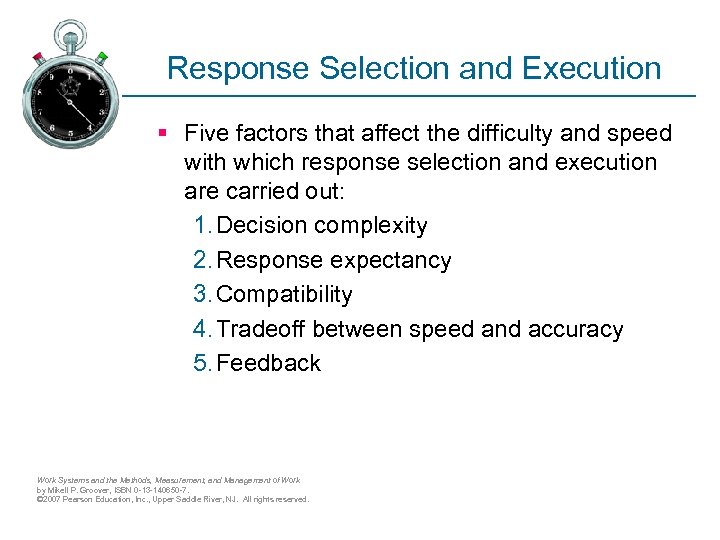 Response Selection and Execution § Five factors that affect the difficulty and speed with which response selection and execution are carried out: 1. Decision complexity 2. Response expectancy 3. Compatibility 4. Tradeoff between speed and accuracy 5. Feedback Work Systems and the Methods, Measurement, and Management of Work by Mikell P. Groover, ISBN 0 -13 -140650 -7. © 2007 Pearson Education, Inc. , Upper Saddle River, NJ. All rights reserved.
Response Selection and Execution § Five factors that affect the difficulty and speed with which response selection and execution are carried out: 1. Decision complexity 2. Response expectancy 3. Compatibility 4. Tradeoff between speed and accuracy 5. Feedback Work Systems and the Methods, Measurement, and Management of Work by Mikell P. Groover, ISBN 0 -13 -140650 -7. © 2007 Pearson Education, Inc. , Upper Saddle River, NJ. All rights reserved.
 Decision Complexity Refers to the number of possible alternative responses that could be selected in response selection § As more choices become available, the complexity of the decision process increases § And the time to make the selection increases § Hick-Hyman law of reaction time: RT = a + b Log 2 N where RT = reaction time, N = number of possible choices Work Systems and the Methods, Measurement, and Management of Work by Mikell P. Groover, ISBN 0 -13 -140650 -7. © 2007 Pearson Education, Inc. , Upper Saddle River, NJ. All rights reserved.
Decision Complexity Refers to the number of possible alternative responses that could be selected in response selection § As more choices become available, the complexity of the decision process increases § And the time to make the selection increases § Hick-Hyman law of reaction time: RT = a + b Log 2 N where RT = reaction time, N = number of possible choices Work Systems and the Methods, Measurement, and Management of Work by Mikell P. Groover, ISBN 0 -13 -140650 -7. © 2007 Pearson Education, Inc. , Upper Saddle River, NJ. All rights reserved.
 Response Expectancy Refers to the fact that humans can process information they are expecting much faster than information they are not expecting § Similarly, humans can select a response they are expecting to choose more quickly than one that is unexpected § Example: Machine operator must press a start button to begin each work cycle when the green light goes on § But if the red light turns on, the response will be delayed because it was unexpected Work Systems and the Methods, Measurement, and Management of Work by Mikell P. Groover, ISBN 0 -13 -140650 -7. © 2007 Pearson Education, Inc. , Upper Saddle River, NJ. All rights reserved.
Response Expectancy Refers to the fact that humans can process information they are expecting much faster than information they are not expecting § Similarly, humans can select a response they are expecting to choose more quickly than one that is unexpected § Example: Machine operator must press a start button to begin each work cycle when the green light goes on § But if the red light turns on, the response will be delayed because it was unexpected Work Systems and the Methods, Measurement, and Management of Work by Mikell P. Groover, ISBN 0 -13 -140650 -7. © 2007 Pearson Education, Inc. , Upper Saddle River, NJ. All rights reserved.
 Response Compatibility Refers to the relationship between a stimulus and the expected consequence of a given response to that stimulus § Closely related to expectancy § Example: When flipping a wall switch for a light, we expect the up position to turn on the light and the down position to turn off the light § Response compatibility means that the possible responses should be consistent with one’s expectations Work Systems and the Methods, Measurement, and Management of Work by Mikell P. Groover, ISBN 0 -13 -140650 -7. © 2007 Pearson Education, Inc. , Upper Saddle River, NJ. All rights reserved.
Response Compatibility Refers to the relationship between a stimulus and the expected consequence of a given response to that stimulus § Closely related to expectancy § Example: When flipping a wall switch for a light, we expect the up position to turn on the light and the down position to turn off the light § Response compatibility means that the possible responses should be consistent with one’s expectations Work Systems and the Methods, Measurement, and Management of Work by Mikell P. Groover, ISBN 0 -13 -140650 -7. © 2007 Pearson Education, Inc. , Upper Saddle River, NJ. All rights reserved.
 Types of Compatibility § Conceptual compatibility - concerned with associations people have between codes or symbols and the things they are supposed to represent § Example: octagonal shape of a stop sign § Spatial compatibility - Physical arrangement of controls and their corresponding labels § Movement compatibility - refers to relationship between moving a control in a certain direction and the expected result due to the movement § Example: radio volume dial Work Systems and the Methods, Measurement, and Management of Work by Mikell P. Groover, ISBN 0 -13 -140650 -7. © 2007 Pearson Education, Inc. , Upper Saddle River, NJ. All rights reserved.
Types of Compatibility § Conceptual compatibility - concerned with associations people have between codes or symbols and the things they are supposed to represent § Example: octagonal shape of a stop sign § Spatial compatibility - Physical arrangement of controls and their corresponding labels § Movement compatibility - refers to relationship between moving a control in a certain direction and the expected result due to the movement § Example: radio volume dial Work Systems and the Methods, Measurement, and Management of Work by Mikell P. Groover, ISBN 0 -13 -140650 -7. © 2007 Pearson Education, Inc. , Upper Saddle River, NJ. All rights reserved.
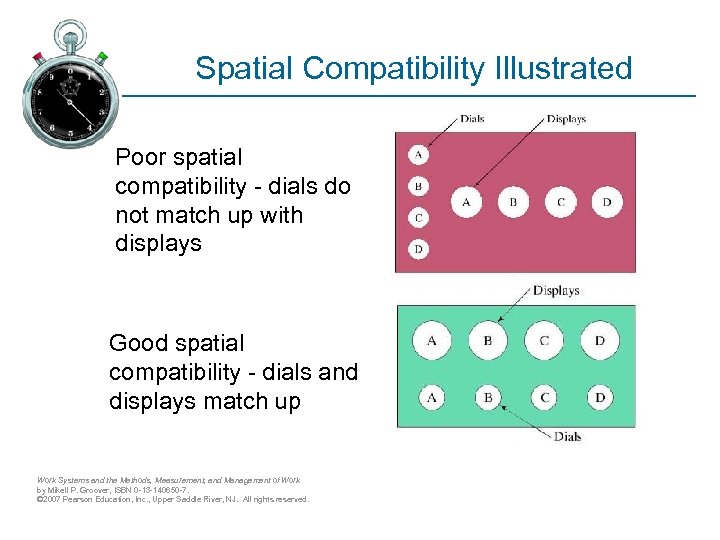 Spatial Compatibility Illustrated Poor spatial compatibility - dials do not match up with displays Good spatial compatibility - dials and displays match up Work Systems and the Methods, Measurement, and Management of Work by Mikell P. Groover, ISBN 0 -13 -140650 -7. © 2007 Pearson Education, Inc. , Upper Saddle River, NJ. All rights reserved.
Spatial Compatibility Illustrated Poor spatial compatibility - dials do not match up with displays Good spatial compatibility - dials and displays match up Work Systems and the Methods, Measurement, and Management of Work by Mikell P. Groover, ISBN 0 -13 -140650 -7. © 2007 Pearson Education, Inc. , Upper Saddle River, NJ. All rights reserved.
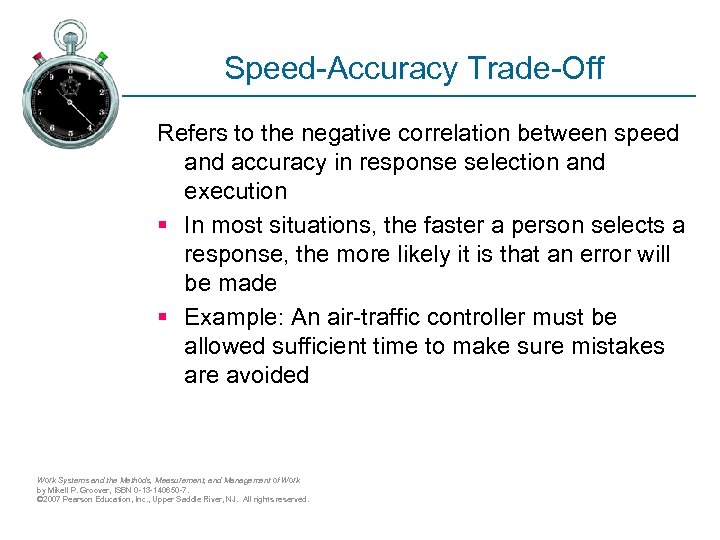 Speed-Accuracy Trade-Off Refers to the negative correlation between speed and accuracy in response selection and execution § In most situations, the faster a person selects a response, the more likely it is that an error will be made § Example: An air-traffic controller must be allowed sufficient time to make sure mistakes are avoided Work Systems and the Methods, Measurement, and Management of Work by Mikell P. Groover, ISBN 0 -13 -140650 -7. © 2007 Pearson Education, Inc. , Upper Saddle River, NJ. All rights reserved.
Speed-Accuracy Trade-Off Refers to the negative correlation between speed and accuracy in response selection and execution § In most situations, the faster a person selects a response, the more likely it is that an error will be made § Example: An air-traffic controller must be allowed sufficient time to make sure mistakes are avoided Work Systems and the Methods, Measurement, and Management of Work by Mikell P. Groover, ISBN 0 -13 -140650 -7. © 2007 Pearson Education, Inc. , Upper Saddle River, NJ. All rights reserved.
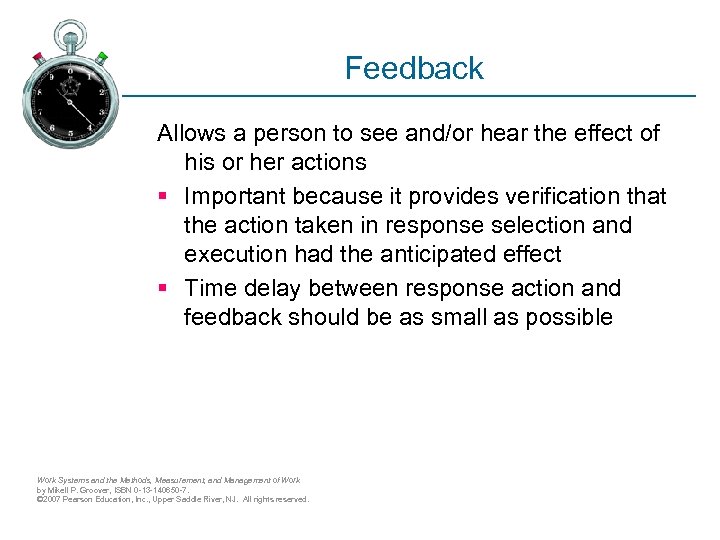 Feedback Allows a person to see and/or hear the effect of his or her actions § Important because it provides verification that the action taken in response selection and execution had the anticipated effect § Time delay between response action and feedback should be as small as possible Work Systems and the Methods, Measurement, and Management of Work by Mikell P. Groover, ISBN 0 -13 -140650 -7. © 2007 Pearson Education, Inc. , Upper Saddle River, NJ. All rights reserved.
Feedback Allows a person to see and/or hear the effect of his or her actions § Important because it provides verification that the action taken in response selection and execution had the anticipated effect § Time delay between response action and feedback should be as small as possible Work Systems and the Methods, Measurement, and Management of Work by Mikell P. Groover, ISBN 0 -13 -140650 -7. © 2007 Pearson Education, Inc. , Upper Saddle River, NJ. All rights reserved.
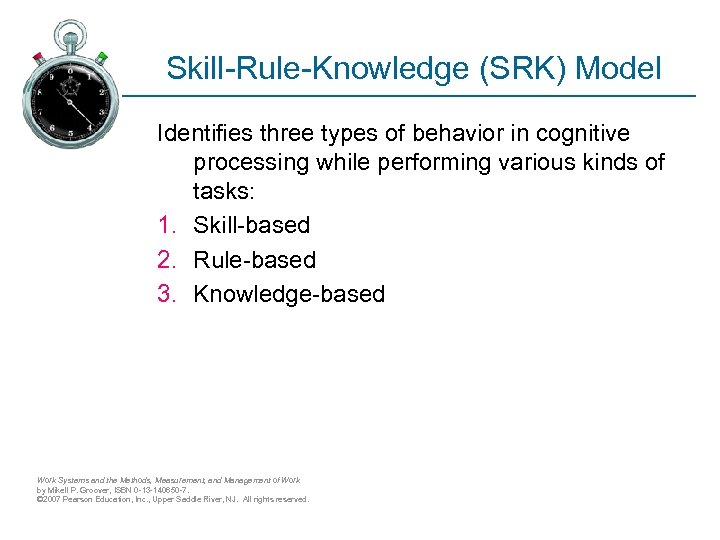 Skill-Rule-Knowledge (SRK) Model Identifies three types of behavior in cognitive processing while performing various kinds of tasks: 1. Skill-based 2. Rule-based 3. Knowledge-based Work Systems and the Methods, Measurement, and Management of Work by Mikell P. Groover, ISBN 0 -13 -140650 -7. © 2007 Pearson Education, Inc. , Upper Saddle River, NJ. All rights reserved.
Skill-Rule-Knowledge (SRK) Model Identifies three types of behavior in cognitive processing while performing various kinds of tasks: 1. Skill-based 2. Rule-based 3. Knowledge-based Work Systems and the Methods, Measurement, and Management of Work by Mikell P. Groover, ISBN 0 -13 -140650 -7. © 2007 Pearson Education, Inc. , Upper Saddle River, NJ. All rights reserved.
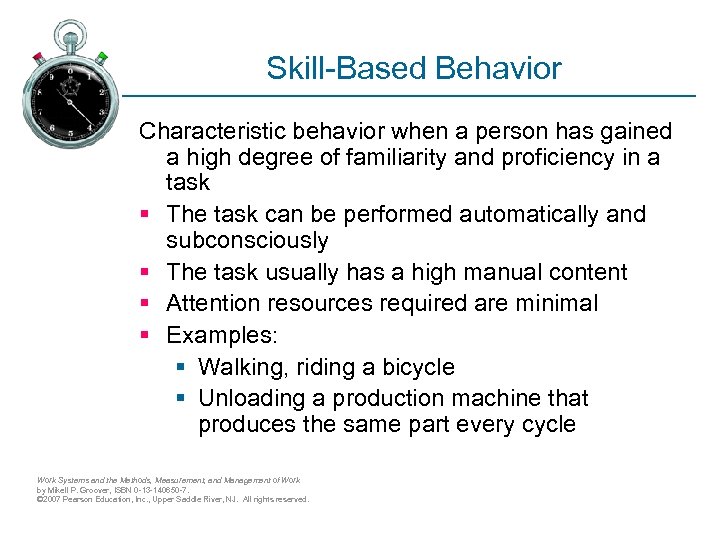 Skill-Based Behavior Characteristic behavior when a person has gained a high degree of familiarity and proficiency in a task § The task can be performed automatically and subconsciously § The task usually has a high manual content § Attention resources required are minimal § Examples: § Walking, riding a bicycle § Unloading a production machine that produces the same part every cycle Work Systems and the Methods, Measurement, and Management of Work by Mikell P. Groover, ISBN 0 -13 -140650 -7. © 2007 Pearson Education, Inc. , Upper Saddle River, NJ. All rights reserved.
Skill-Based Behavior Characteristic behavior when a person has gained a high degree of familiarity and proficiency in a task § The task can be performed automatically and subconsciously § The task usually has a high manual content § Attention resources required are minimal § Examples: § Walking, riding a bicycle § Unloading a production machine that produces the same part every cycle Work Systems and the Methods, Measurement, and Management of Work by Mikell P. Groover, ISBN 0 -13 -140650 -7. © 2007 Pearson Education, Inc. , Upper Saddle River, NJ. All rights reserved.
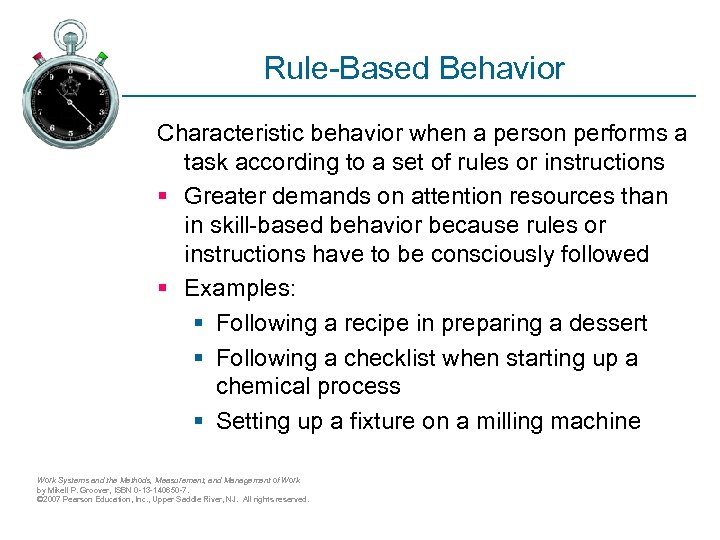 Rule-Based Behavior Characteristic behavior when a person performs a task according to a set of rules or instructions § Greater demands on attention resources than in skill-based behavior because rules or instructions have to be consciously followed § Examples: § Following a recipe in preparing a dessert § Following a checklist when starting up a chemical process § Setting up a fixture on a milling machine Work Systems and the Methods, Measurement, and Management of Work by Mikell P. Groover, ISBN 0 -13 -140650 -7. © 2007 Pearson Education, Inc. , Upper Saddle River, NJ. All rights reserved.
Rule-Based Behavior Characteristic behavior when a person performs a task according to a set of rules or instructions § Greater demands on attention resources than in skill-based behavior because rules or instructions have to be consciously followed § Examples: § Following a recipe in preparing a dessert § Following a checklist when starting up a chemical process § Setting up a fixture on a milling machine Work Systems and the Methods, Measurement, and Management of Work by Mikell P. Groover, ISBN 0 -13 -140650 -7. © 2007 Pearson Education, Inc. , Upper Saddle River, NJ. All rights reserved.
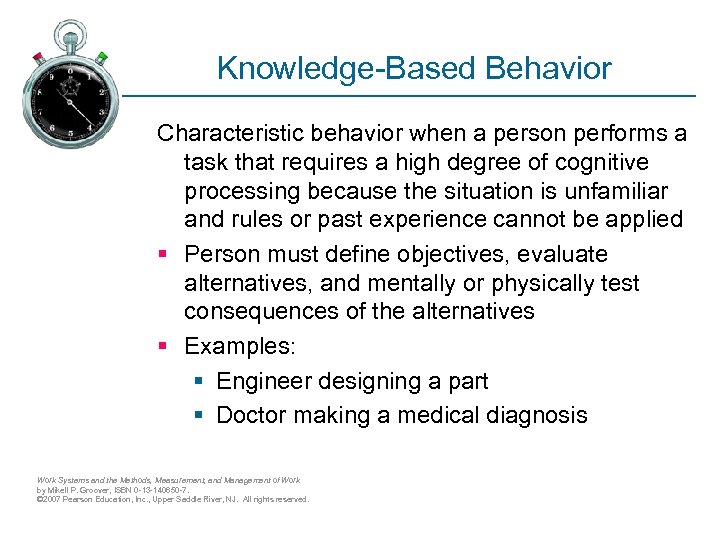 Knowledge-Based Behavior Characteristic behavior when a person performs a task that requires a high degree of cognitive processing because the situation is unfamiliar and rules or past experience cannot be applied § Person must define objectives, evaluate alternatives, and mentally or physically test consequences of the alternatives § Examples: § Engineer designing a part § Doctor making a medical diagnosis Work Systems and the Methods, Measurement, and Management of Work by Mikell P. Groover, ISBN 0 -13 -140650 -7. © 2007 Pearson Education, Inc. , Upper Saddle River, NJ. All rights reserved.
Knowledge-Based Behavior Characteristic behavior when a person performs a task that requires a high degree of cognitive processing because the situation is unfamiliar and rules or past experience cannot be applied § Person must define objectives, evaluate alternatives, and mentally or physically test consequences of the alternatives § Examples: § Engineer designing a part § Doctor making a medical diagnosis Work Systems and the Methods, Measurement, and Management of Work by Mikell P. Groover, ISBN 0 -13 -140650 -7. © 2007 Pearson Education, Inc. , Upper Saddle River, NJ. All rights reserved.
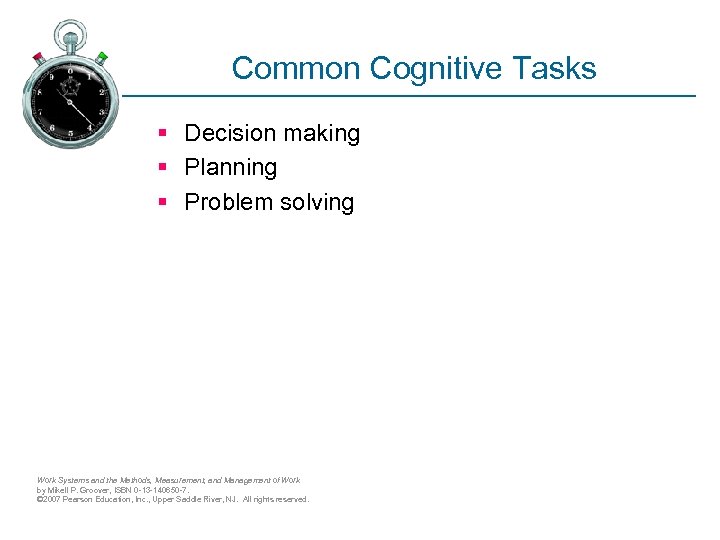 Common Cognitive Tasks § Decision making § Planning § Problem solving Work Systems and the Methods, Measurement, and Management of Work by Mikell P. Groover, ISBN 0 -13 -140650 -7. © 2007 Pearson Education, Inc. , Upper Saddle River, NJ. All rights reserved.
Common Cognitive Tasks § Decision making § Planning § Problem solving Work Systems and the Methods, Measurement, and Management of Work by Mikell P. Groover, ISBN 0 -13 -140650 -7. © 2007 Pearson Education, Inc. , Upper Saddle River, NJ. All rights reserved.
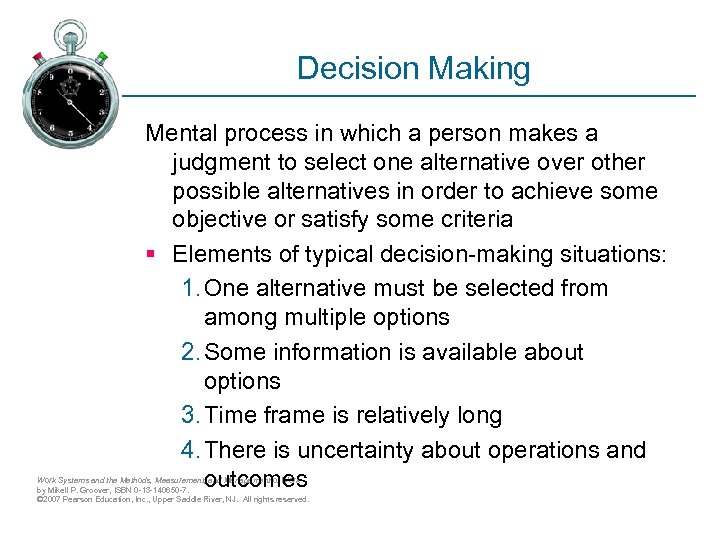 Decision Making Mental process in which a person makes a judgment to select one alternative over other possible alternatives in order to achieve some objective or satisfy some criteria § Elements of typical decision-making situations: 1. One alternative must be selected from among multiple options 2. Some information is available about options 3. Time frame is relatively long 4. There is uncertainty about operations and outcomes Work Systems and the Methods, Measurement, and Management of Work by Mikell P. Groover, ISBN 0 -13 -140650 -7. © 2007 Pearson Education, Inc. , Upper Saddle River, NJ. All rights reserved.
Decision Making Mental process in which a person makes a judgment to select one alternative over other possible alternatives in order to achieve some objective or satisfy some criteria § Elements of typical decision-making situations: 1. One alternative must be selected from among multiple options 2. Some information is available about options 3. Time frame is relatively long 4. There is uncertainty about operations and outcomes Work Systems and the Methods, Measurement, and Management of Work by Mikell P. Groover, ISBN 0 -13 -140650 -7. © 2007 Pearson Education, Inc. , Upper Saddle River, NJ. All rights reserved.
 Models of Decision Making 1. Rational decision models § Emphasis on logical or quantitative selection among options 2. Descriptive decision models § Emphasis on the cognitive and behavioral aspects of human decision making Work Systems and the Methods, Measurement, and Management of Work by Mikell P. Groover, ISBN 0 -13 -140650 -7. © 2007 Pearson Education, Inc. , Upper Saddle River, NJ. All rights reserved.
Models of Decision Making 1. Rational decision models § Emphasis on logical or quantitative selection among options 2. Descriptive decision models § Emphasis on the cognitive and behavioral aspects of human decision making Work Systems and the Methods, Measurement, and Management of Work by Mikell P. Groover, ISBN 0 -13 -140650 -7. © 2007 Pearson Education, Inc. , Upper Saddle River, NJ. All rights reserved.
 Rational Decision Models § The way people should make decisions § Overall score is determined for each option to judge which should be selected § Example: § State lottery worth $20 million. Ticket costs $1. 00. Chances of winning per ticket = 1/700 million. Should a person buy 5 tickets? § Solution: Expected value of investment § E(V) = 5(1/700, 000)($20, 000) - $5 E(V) = -$4. 86 § Person should not buy 5 lottery tickets Work Systems and the Methods, Measurement, and Management of Work by Mikell P. Groover, ISBN 0 -13 -140650 -7. © 2007 Pearson Education, Inc. , Upper Saddle River, NJ. All rights reserved.
Rational Decision Models § The way people should make decisions § Overall score is determined for each option to judge which should be selected § Example: § State lottery worth $20 million. Ticket costs $1. 00. Chances of winning per ticket = 1/700 million. Should a person buy 5 tickets? § Solution: Expected value of investment § E(V) = 5(1/700, 000)($20, 000) - $5 E(V) = -$4. 86 § Person should not buy 5 lottery tickets Work Systems and the Methods, Measurement, and Management of Work by Mikell P. Groover, ISBN 0 -13 -140650 -7. © 2007 Pearson Education, Inc. , Upper Saddle River, NJ. All rights reserved.
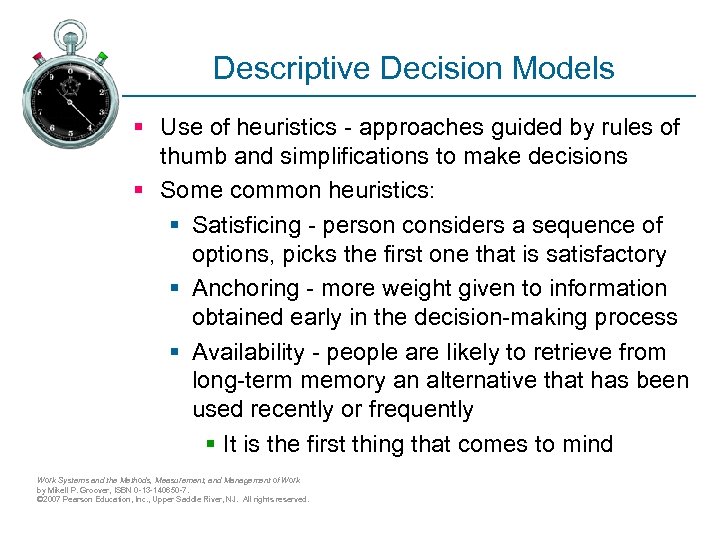 Descriptive Decision Models § Use of heuristics - approaches guided by rules of thumb and simplifications to make decisions § Some common heuristics: § Satisficing - person considers a sequence of options, picks the first one that is satisfactory § Anchoring - more weight given to information obtained early in the decision-making process § Availability - people are likely to retrieve from long-term memory an alternative that has been used recently or frequently § It is the first thing that comes to mind Work Systems and the Methods, Measurement, and Management of Work by Mikell P. Groover, ISBN 0 -13 -140650 -7. © 2007 Pearson Education, Inc. , Upper Saddle River, NJ. All rights reserved.
Descriptive Decision Models § Use of heuristics - approaches guided by rules of thumb and simplifications to make decisions § Some common heuristics: § Satisficing - person considers a sequence of options, picks the first one that is satisfactory § Anchoring - more weight given to information obtained early in the decision-making process § Availability - people are likely to retrieve from long-term memory an alternative that has been used recently or frequently § It is the first thing that comes to mind Work Systems and the Methods, Measurement, and Management of Work by Mikell P. Groover, ISBN 0 -13 -140650 -7. © 2007 Pearson Education, Inc. , Upper Saddle River, NJ. All rights reserved.
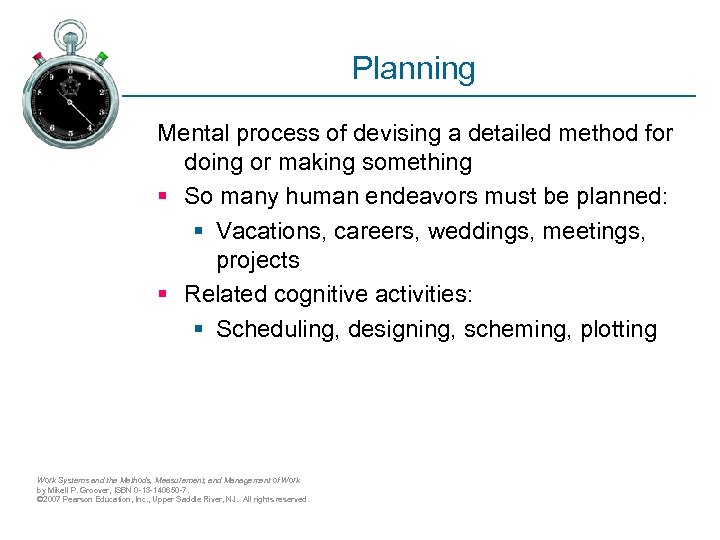 Planning Mental process of devising a detailed method for doing or making something § So many human endeavors must be planned: § Vacations, careers, weddings, meetings, projects § Related cognitive activities: § Scheduling, designing, scheming, plotting Work Systems and the Methods, Measurement, and Management of Work by Mikell P. Groover, ISBN 0 -13 -140650 -7. © 2007 Pearson Education, Inc. , Upper Saddle River, NJ. All rights reserved.
Planning Mental process of devising a detailed method for doing or making something § So many human endeavors must be planned: § Vacations, careers, weddings, meetings, projects § Related cognitive activities: § Scheduling, designing, scheming, plotting Work Systems and the Methods, Measurement, and Management of Work by Mikell P. Groover, ISBN 0 -13 -140650 -7. © 2007 Pearson Education, Inc. , Upper Saddle River, NJ. All rights reserved.
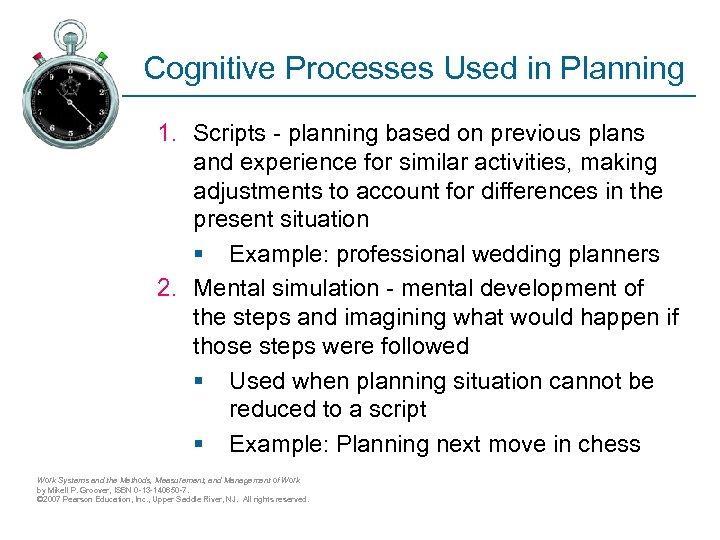 Cognitive Processes Used in Planning 1. Scripts - planning based on previous plans and experience for similar activities, making adjustments to account for differences in the present situation § Example: professional wedding planners 2. Mental simulation - mental development of the steps and imagining what would happen if those steps were followed § Used when planning situation cannot be reduced to a script § Example: Planning next move in chess Work Systems and the Methods, Measurement, and Management of Work by Mikell P. Groover, ISBN 0 -13 -140650 -7. © 2007 Pearson Education, Inc. , Upper Saddle River, NJ. All rights reserved.
Cognitive Processes Used in Planning 1. Scripts - planning based on previous plans and experience for similar activities, making adjustments to account for differences in the present situation § Example: professional wedding planners 2. Mental simulation - mental development of the steps and imagining what would happen if those steps were followed § Used when planning situation cannot be reduced to a script § Example: Planning next move in chess Work Systems and the Methods, Measurement, and Management of Work by Mikell P. Groover, ISBN 0 -13 -140650 -7. © 2007 Pearson Education, Inc. , Upper Saddle River, NJ. All rights reserved.
 Problem Solving Mental process in which a question or issue is considered analyzed to determine an appropriate answer or solution § Arriving at a solution may require: § Mathematical calculations § Brainstorming § Analysis and diagnosis § Evaluation of alternatives § Creative design work § Combinations of these cognitive activities Work Systems and the Methods, Measurement, and Management of Work by Mikell P. Groover, ISBN 0 -13 -140650 -7. © 2007 Pearson Education, Inc. , Upper Saddle River, NJ. All rights reserved.
Problem Solving Mental process in which a question or issue is considered analyzed to determine an appropriate answer or solution § Arriving at a solution may require: § Mathematical calculations § Brainstorming § Analysis and diagnosis § Evaluation of alternatives § Creative design work § Combinations of these cognitive activities Work Systems and the Methods, Measurement, and Management of Work by Mikell P. Groover, ISBN 0 -13 -140650 -7. © 2007 Pearson Education, Inc. , Upper Saddle River, NJ. All rights reserved.
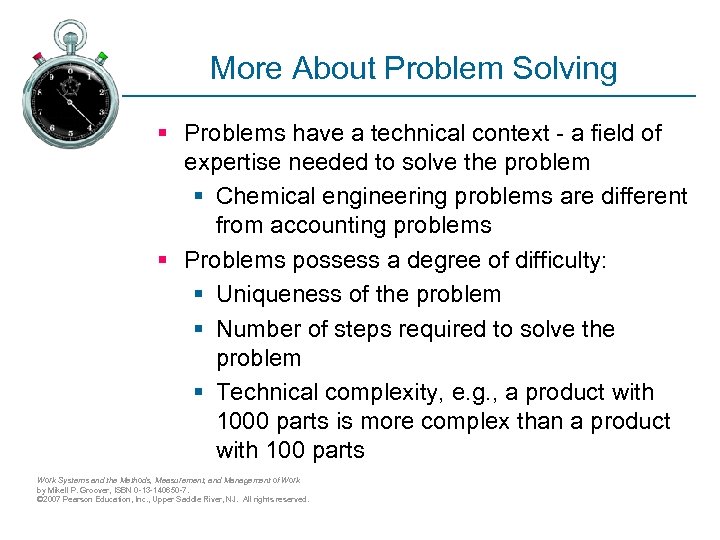 More About Problem Solving § Problems have a technical context - a field of expertise needed to solve the problem § Chemical engineering problems are different from accounting problems § Problems possess a degree of difficulty: § Uniqueness of the problem § Number of steps required to solve the problem § Technical complexity, e. g. , a product with 1000 parts is more complex than a product with 100 parts Work Systems and the Methods, Measurement, and Management of Work by Mikell P. Groover, ISBN 0 -13 -140650 -7. © 2007 Pearson Education, Inc. , Upper Saddle River, NJ. All rights reserved.
More About Problem Solving § Problems have a technical context - a field of expertise needed to solve the problem § Chemical engineering problems are different from accounting problems § Problems possess a degree of difficulty: § Uniqueness of the problem § Number of steps required to solve the problem § Technical complexity, e. g. , a product with 1000 parts is more complex than a product with 100 parts Work Systems and the Methods, Measurement, and Management of Work by Mikell P. Groover, ISBN 0 -13 -140650 -7. © 2007 Pearson Education, Inc. , Upper Saddle River, NJ. All rights reserved.
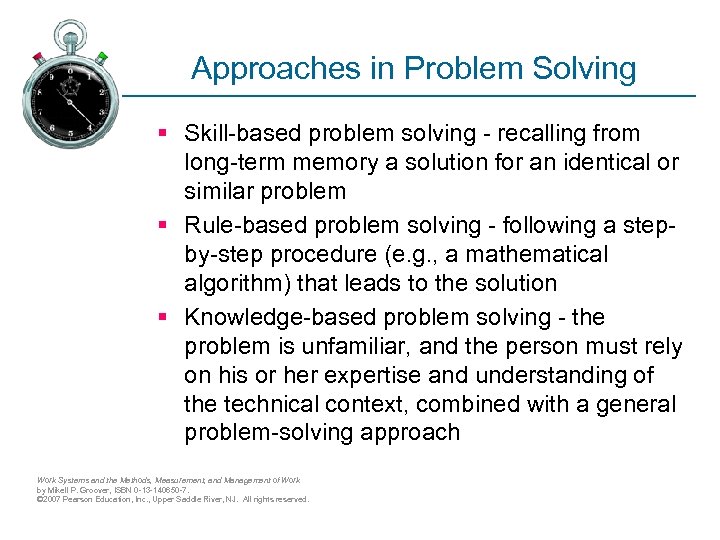 Approaches in Problem Solving § Skill-based problem solving - recalling from long-term memory a solution for an identical or similar problem § Rule-based problem solving - following a stepby-step procedure (e. g. , a mathematical algorithm) that leads to the solution § Knowledge-based problem solving - the problem is unfamiliar, and the person must rely on his or her expertise and understanding of the technical context, combined with a general problem-solving approach Work Systems and the Methods, Measurement, and Management of Work by Mikell P. Groover, ISBN 0 -13 -140650 -7. © 2007 Pearson Education, Inc. , Upper Saddle River, NJ. All rights reserved.
Approaches in Problem Solving § Skill-based problem solving - recalling from long-term memory a solution for an identical or similar problem § Rule-based problem solving - following a stepby-step procedure (e. g. , a mathematical algorithm) that leads to the solution § Knowledge-based problem solving - the problem is unfamiliar, and the person must rely on his or her expertise and understanding of the technical context, combined with a general problem-solving approach Work Systems and the Methods, Measurement, and Management of Work by Mikell P. Groover, ISBN 0 -13 -140650 -7. © 2007 Pearson Education, Inc. , Upper Saddle River, NJ. All rights reserved.
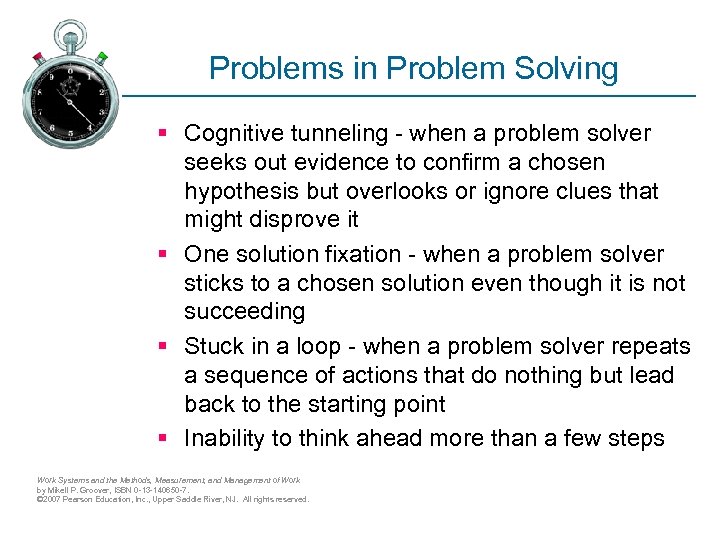 Problems in Problem Solving § Cognitive tunneling - when a problem solver seeks out evidence to confirm a chosen hypothesis but overlooks or ignore clues that might disprove it § One solution fixation - when a problem solver sticks to a chosen solution even though it is not succeeding § Stuck in a loop - when a problem solver repeats a sequence of actions that do nothing but lead back to the starting point § Inability to think ahead more than a few steps Work Systems and the Methods, Measurement, and Management of Work by Mikell P. Groover, ISBN 0 -13 -140650 -7. © 2007 Pearson Education, Inc. , Upper Saddle River, NJ. All rights reserved.
Problems in Problem Solving § Cognitive tunneling - when a problem solver seeks out evidence to confirm a chosen hypothesis but overlooks or ignore clues that might disprove it § One solution fixation - when a problem solver sticks to a chosen solution even though it is not succeeding § Stuck in a loop - when a problem solver repeats a sequence of actions that do nothing but lead back to the starting point § Inability to think ahead more than a few steps Work Systems and the Methods, Measurement, and Management of Work by Mikell P. Groover, ISBN 0 -13 -140650 -7. © 2007 Pearson Education, Inc. , Upper Saddle River, NJ. All rights reserved.
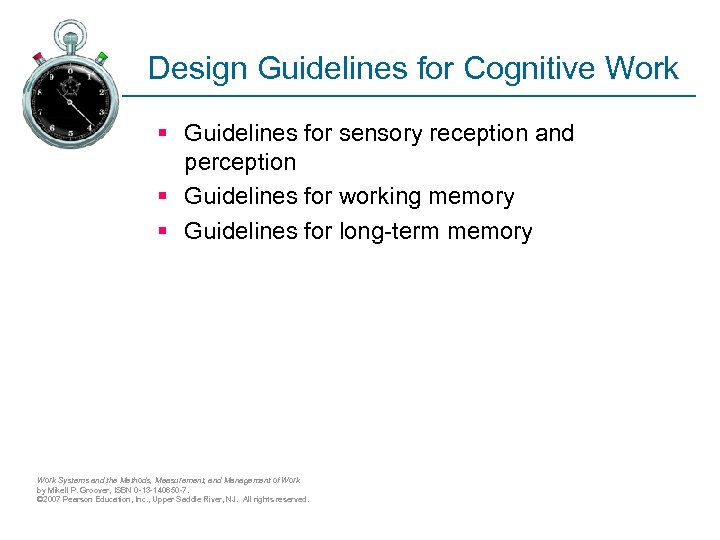 Design Guidelines for Cognitive Work § Guidelines for sensory reception and perception § Guidelines for working memory § Guidelines for long-term memory Work Systems and the Methods, Measurement, and Management of Work by Mikell P. Groover, ISBN 0 -13 -140650 -7. © 2007 Pearson Education, Inc. , Upper Saddle River, NJ. All rights reserved.
Design Guidelines for Cognitive Work § Guidelines for sensory reception and perception § Guidelines for working memory § Guidelines for long-term memory Work Systems and the Methods, Measurement, and Management of Work by Mikell P. Groover, ISBN 0 -13 -140650 -7. © 2007 Pearson Education, Inc. , Upper Saddle River, NJ. All rights reserved.
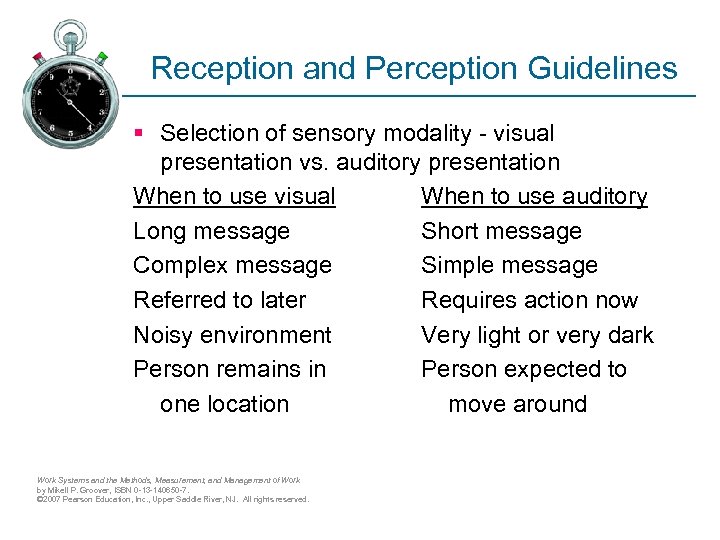 Reception and Perception Guidelines § Selection of sensory modality - visual presentation vs. auditory presentation When to use visual When to use auditory Long message Short message Complex message Simple message Referred to later Requires action now Noisy environment Very light or very dark Person remains in Person expected to one location move around Work Systems and the Methods, Measurement, and Management of Work by Mikell P. Groover, ISBN 0 -13 -140650 -7. © 2007 Pearson Education, Inc. , Upper Saddle River, NJ. All rights reserved.
Reception and Perception Guidelines § Selection of sensory modality - visual presentation vs. auditory presentation When to use visual When to use auditory Long message Short message Complex message Simple message Referred to later Requires action now Noisy environment Very light or very dark Person remains in Person expected to one location move around Work Systems and the Methods, Measurement, and Management of Work by Mikell P. Groover, ISBN 0 -13 -140650 -7. © 2007 Pearson Education, Inc. , Upper Saddle River, NJ. All rights reserved.
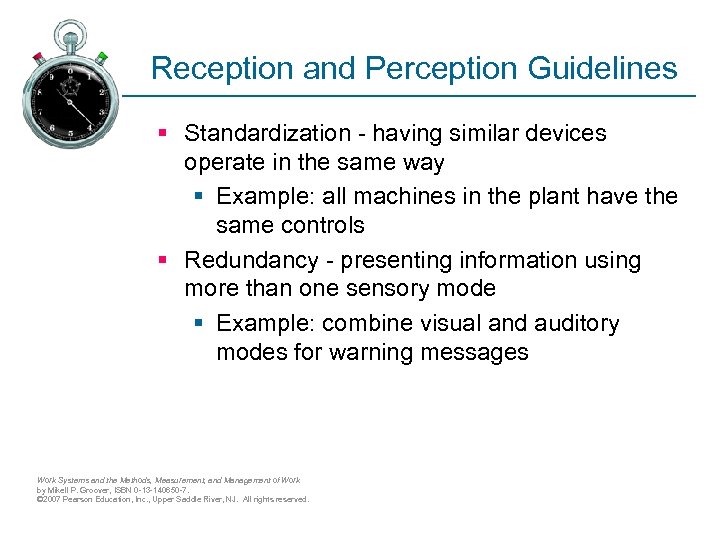 Reception and Perception Guidelines § Standardization - having similar devices operate in the same way § Example: all machines in the plant have the same controls § Redundancy - presenting information using more than one sensory mode § Example: combine visual and auditory modes for warning messages Work Systems and the Methods, Measurement, and Management of Work by Mikell P. Groover, ISBN 0 -13 -140650 -7. © 2007 Pearson Education, Inc. , Upper Saddle River, NJ. All rights reserved.
Reception and Perception Guidelines § Standardization - having similar devices operate in the same way § Example: all machines in the plant have the same controls § Redundancy - presenting information using more than one sensory mode § Example: combine visual and auditory modes for warning messages Work Systems and the Methods, Measurement, and Management of Work by Mikell P. Groover, ISBN 0 -13 -140650 -7. © 2007 Pearson Education, Inc. , Upper Saddle River, NJ. All rights reserved.
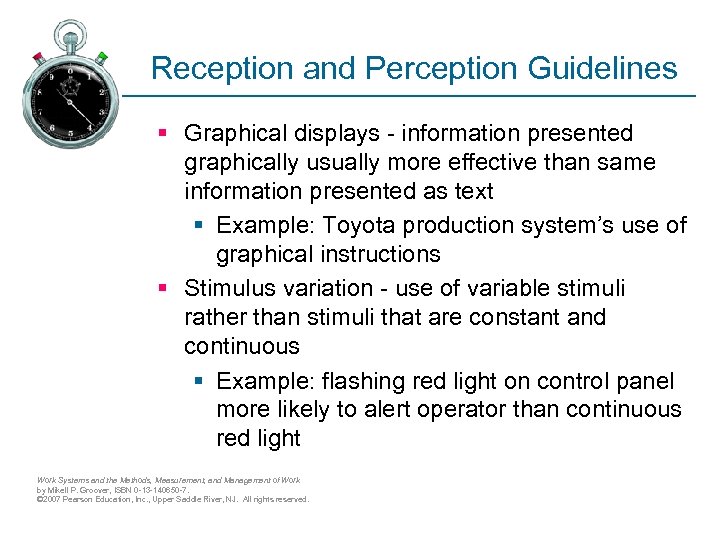 Reception and Perception Guidelines § Graphical displays - information presented graphically usually more effective than same information presented as text § Example: Toyota production system’s use of graphical instructions § Stimulus variation - use of variable stimuli rather than stimuli that are constant and continuous § Example: flashing red light on control panel more likely to alert operator than continuous red light Work Systems and the Methods, Measurement, and Management of Work by Mikell P. Groover, ISBN 0 -13 -140650 -7. © 2007 Pearson Education, Inc. , Upper Saddle River, NJ. All rights reserved.
Reception and Perception Guidelines § Graphical displays - information presented graphically usually more effective than same information presented as text § Example: Toyota production system’s use of graphical instructions § Stimulus variation - use of variable stimuli rather than stimuli that are constant and continuous § Example: flashing red light on control panel more likely to alert operator than continuous red light Work Systems and the Methods, Measurement, and Management of Work by Mikell P. Groover, ISBN 0 -13 -140650 -7. © 2007 Pearson Education, Inc. , Upper Saddle River, NJ. All rights reserved.
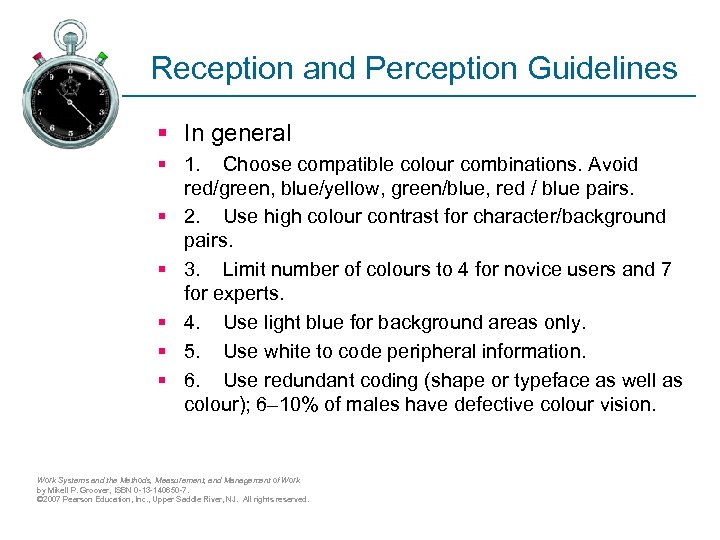 Reception and Perception Guidelines § In general § 1. Choose compatible colour combinations. Avoid red/green, blue/yellow, green/blue, red / blue pairs. § 2. Use high colour contrast for character/background pairs. § 3. Limit number of colours to 4 for novice users and 7 for experts. § 4. Use light blue for background areas only. § 5. Use white to code peripheral information. § 6. Use redundant coding (shape or typeface as well as colour); 6– 10% of males have defective colour vision. Work Systems and the Methods, Measurement, and Management of Work by Mikell P. Groover, ISBN 0 -13 -140650 -7. © 2007 Pearson Education, Inc. , Upper Saddle River, NJ. All rights reserved.
Reception and Perception Guidelines § In general § 1. Choose compatible colour combinations. Avoid red/green, blue/yellow, green/blue, red / blue pairs. § 2. Use high colour contrast for character/background pairs. § 3. Limit number of colours to 4 for novice users and 7 for experts. § 4. Use light blue for background areas only. § 5. Use white to code peripheral information. § 6. Use redundant coding (shape or typeface as well as colour); 6– 10% of males have defective colour vision. Work Systems and the Methods, Measurement, and Management of Work by Mikell P. Groover, ISBN 0 -13 -140650 -7. © 2007 Pearson Education, Inc. , Upper Saddle River, NJ. All rights reserved.
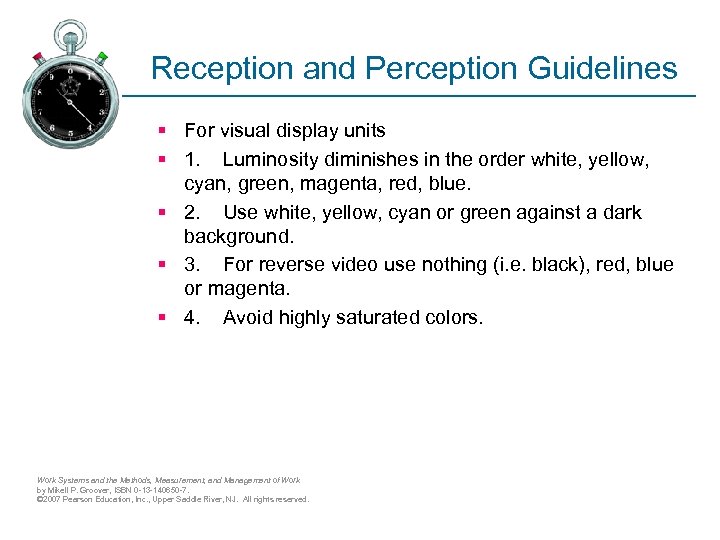 Reception and Perception Guidelines § For visual display units § 1. Luminosity diminishes in the order white, yellow, cyan, green, magenta, red, blue. § 2. Use white, yellow, cyan or green against a dark background. § 3. For reverse video use nothing (i. e. black), red, blue or magenta. § 4. Avoid highly saturated colors. Work Systems and the Methods, Measurement, and Management of Work by Mikell P. Groover, ISBN 0 -13 -140650 -7. © 2007 Pearson Education, Inc. , Upper Saddle River, NJ. All rights reserved.
Reception and Perception Guidelines § For visual display units § 1. Luminosity diminishes in the order white, yellow, cyan, green, magenta, red, blue. § 2. Use white, yellow, cyan or green against a dark background. § 3. For reverse video use nothing (i. e. black), red, blue or magenta. § 4. Avoid highly saturated colors. Work Systems and the Methods, Measurement, and Management of Work by Mikell P. Groover, ISBN 0 -13 -140650 -7. © 2007 Pearson Education, Inc. , Upper Saddle River, NJ. All rights reserved.
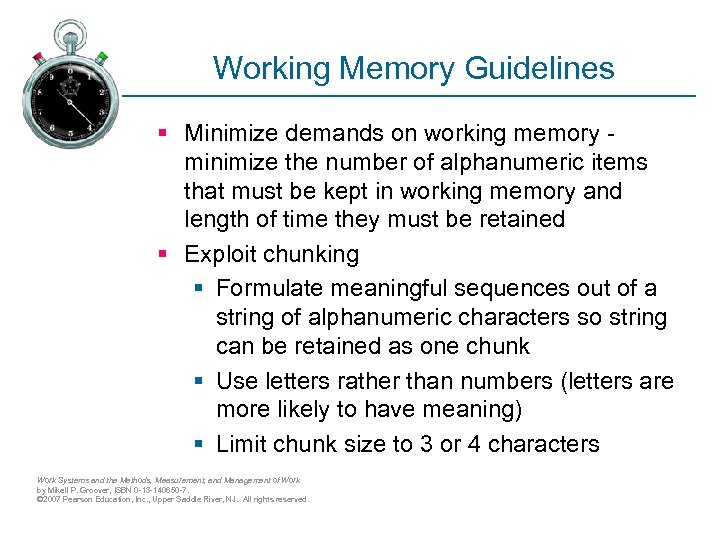 Working Memory Guidelines § Minimize demands on working memory minimize the number of alphanumeric items that must be kept in working memory and length of time they must be retained § Exploit chunking § Formulate meaningful sequences out of a string of alphanumeric characters so string can be retained as one chunk § Use letters rather than numbers (letters are more likely to have meaning) § Limit chunk size to 3 or 4 characters Work Systems and the Methods, Measurement, and Management of Work by Mikell P. Groover, ISBN 0 -13 -140650 -7. © 2007 Pearson Education, Inc. , Upper Saddle River, NJ. All rights reserved.
Working Memory Guidelines § Minimize demands on working memory minimize the number of alphanumeric items that must be kept in working memory and length of time they must be retained § Exploit chunking § Formulate meaningful sequences out of a string of alphanumeric characters so string can be retained as one chunk § Use letters rather than numbers (letters are more likely to have meaning) § Limit chunk size to 3 or 4 characters Work Systems and the Methods, Measurement, and Management of Work by Mikell P. Groover, ISBN 0 -13 -140650 -7. © 2007 Pearson Education, Inc. , Upper Saddle River, NJ. All rights reserved.
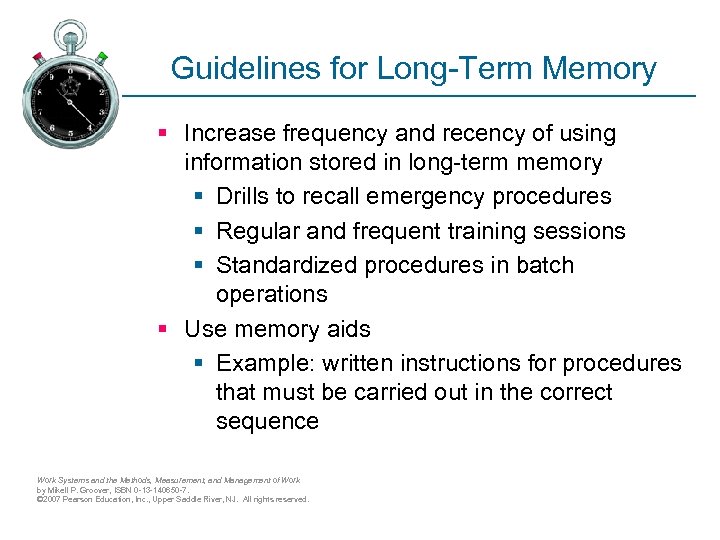 Guidelines for Long-Term Memory § Increase frequency and recency of using information stored in long-term memory § Drills to recall emergency procedures § Regular and frequent training sessions § Standardized procedures in batch operations § Use memory aids § Example: written instructions for procedures that must be carried out in the correct sequence Work Systems and the Methods, Measurement, and Management of Work by Mikell P. Groover, ISBN 0 -13 -140650 -7. © 2007 Pearson Education, Inc. , Upper Saddle River, NJ. All rights reserved.
Guidelines for Long-Term Memory § Increase frequency and recency of using information stored in long-term memory § Drills to recall emergency procedures § Regular and frequent training sessions § Standardized procedures in batch operations § Use memory aids § Example: written instructions for procedures that must be carried out in the correct sequence Work Systems and the Methods, Measurement, and Management of Work by Mikell P. Groover, ISBN 0 -13 -140650 -7. © 2007 Pearson Education, Inc. , Upper Saddle River, NJ. All rights reserved.


